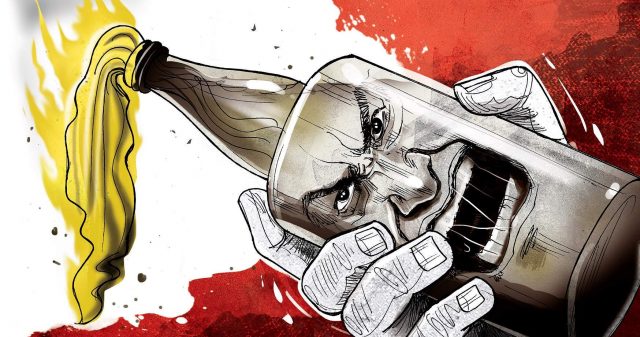
Attending a conference on radicalisation in God’s own country recently, one was struck by both the concern as well as confusion about its rapid spread in certain sections of society in India, especially in Kerala. What’s confounding most people is the fact that an educationally and economically advanced state is the worst affected. The debates were intense and the presentations scholarly. Despite diverse opinions, there was a near consensus on two things: One, radicalisation is a complex phenomenon which needs to be analysed dispassionately. Second, relying only on the police to handle the issue is not going to work.
Understanding radicalisation is perhaps the bigger challenge. It is an incredibly complex phenomenon but previous research (Eidelson, 2003) shows that its psychological roots can be traced to feelings of perceived superiority, injustice, vulnerability, distrust and helplessness in individuals as well as communities. Consequently a narrative or world view of victimhood emerges which is the key precursor of radicalisation. Normally narratives emerge slowly and have complex socio-cultural, economic and historical antecedents, but in some cases states have actively fostered such narratives leading to highly radicalised societies—Pakistan is a prime example. Now questions may be raised as to how this relates to the Indian situation? The straight answer is that it is relevant because we share the same civilisation and cultural heritage and our societies were broadly similar till about the 1980s when the seeds of radicalisation were sown in Pakistan. Perhaps we can learn from our neighbour’s mistakes and avoid reinventing the wheel.
The Pakistan case (or as some would say, basket case) study can be broken down in phases- the first phase lasts till about late 1970s when the society although conservative, was fairly tolerant. Growing up in the border regions of Punjab in the 1970s one was able to have a window into that society through their TV programs. They were quite liberal, modern and popular with the Indian audience. All that changed soon after General Zia-ul-Haq took over in 1977 and started a state-sponsored radicalisation for political objectives of jihad in Afghanistan. Initially such elements were used against external targets in Afghanistan and Kashmir but now all institutions and the society itself have become radicalised.
The long term effects of what has been described succinctly as “drip-drip radicalisation” by Pakistani author and analyst Farahnaz Ispahani are much more insidious and debilitating for society. Consider the following facts: The country’s average annual GDP growth rate from 2001-2016 is just 4.36 per cent as against a robust 7.30 per cent for India. Earlier, it was roughly the same. But this is nothing compared to the socio-political costs paid. The society has become extremely intolerant and violent.
Take for instance blasphemy cases: While only seven such cases were reported till 1977, the number surged to over 5,000 cases from 1977–2014 ever since the imposition of stricter Islamic laws made blasphemy punishable mandatorily by death. What’s worse is that mobs have lynched over 90 people just on mere accusations during 1984–2016 while only two such instances happened from 1947–84. It is well known that blasphemy cases are used as tools to terrorise minority Christian or Hindu communities to grab their lands or settle personal scores.
A new low was recorded recently when a mob of university students (not the usual ragtag crowd) not just brutally lynched a fellow student on mere rumours of blasphemy, but also gleefully took selfies with the mutilated corpse. Further, more than 60,000 Pakistanis have been killed in terror-related violence since 2001. The state legitimacy has been weakened to such an extent that religious fanatics openly defy the authorities and eulogise the killers. Though there is some belated recognition of the perils, the state is still fairly complicit.
What does it mean for India? So far the manifestations of such radicalisation and violence are sporadic. However a similar narrative is prevalent in certain sections. The Eidelson framework also implies that poverty and lack of education are often constraints on mobilisation from mere radicalisation to overt violence. This explains why most cases involve relatively empowered sections. It’s also important to remember that this generic framework is equally applicable to explain extremism in other communities too. One can see the same propensity to choose facts selectively to fit the narrative.
But the most important lesson beyond Islamic radicalisation is about the eroding legitimacy of state institutions of which the police force is one. A seminal study by Tankebe (2009) points out that support for vigilante violence increases where legitimacy of state institutions is weak.
The regularity with which various mobs defy the law, be it khap panchayats, protests on movies, books, art and even road accidents, show that in this respect the difference between India and Pakistan is just a matter of degrees. The horrific violence by “cow vigilantes” is perhaps our equivalent of blasphemy mobs.
For the police, dealing with radicalised minds is hard enough without the baggage of weakened legitimacy. The bottom line is that there is no silver bullet to change the narrative. Measures against terrorists and the radicalised are necessary but not sufficient. The role of police is vital to counter terror but relatively minor in changing the narrative.
To be successful, the counter- narrative has to emerge largely from within the community; if outsiders force the issue, it often leads to resistance.
However the final lesson is also about the power of the state to drive a narrative. The Pakistani state actively promoted the narrative of hate and it is now reaping the harvest. There are many lessons for us to learn, if we really want to.
Manoj Chhabra
Additional Director General, Odisha and PhD scholar, IIT Delhi
Courtesy: New Indian Express














